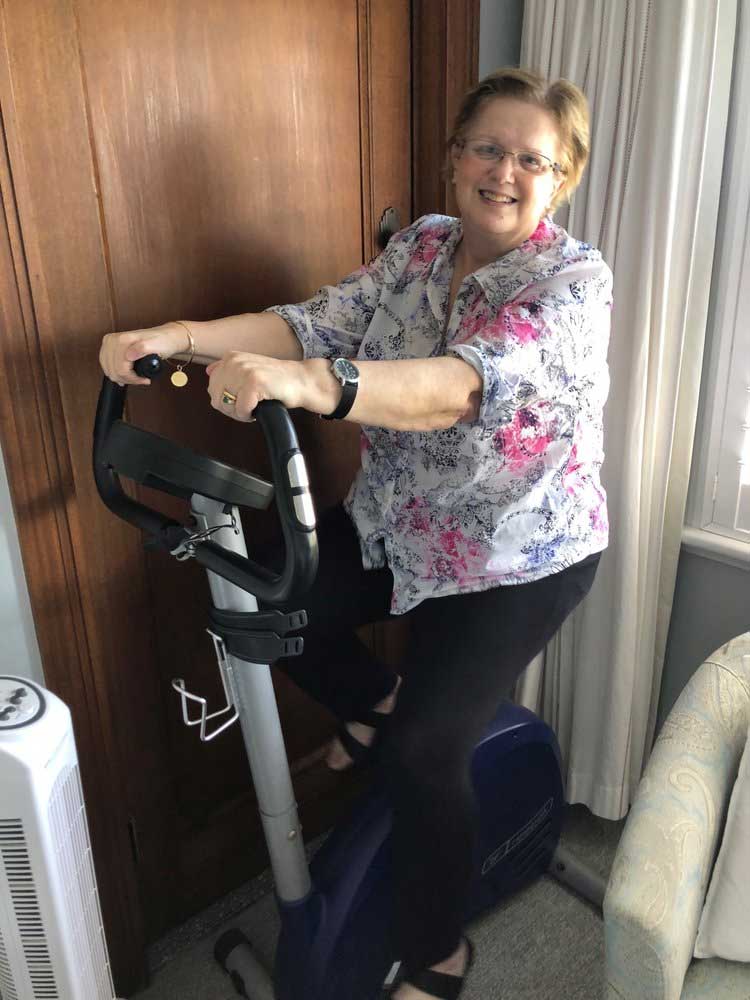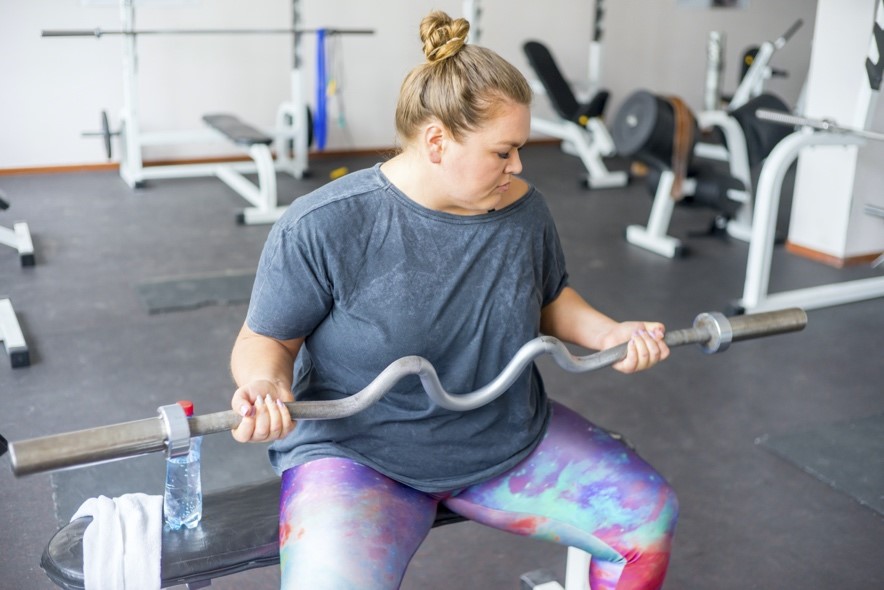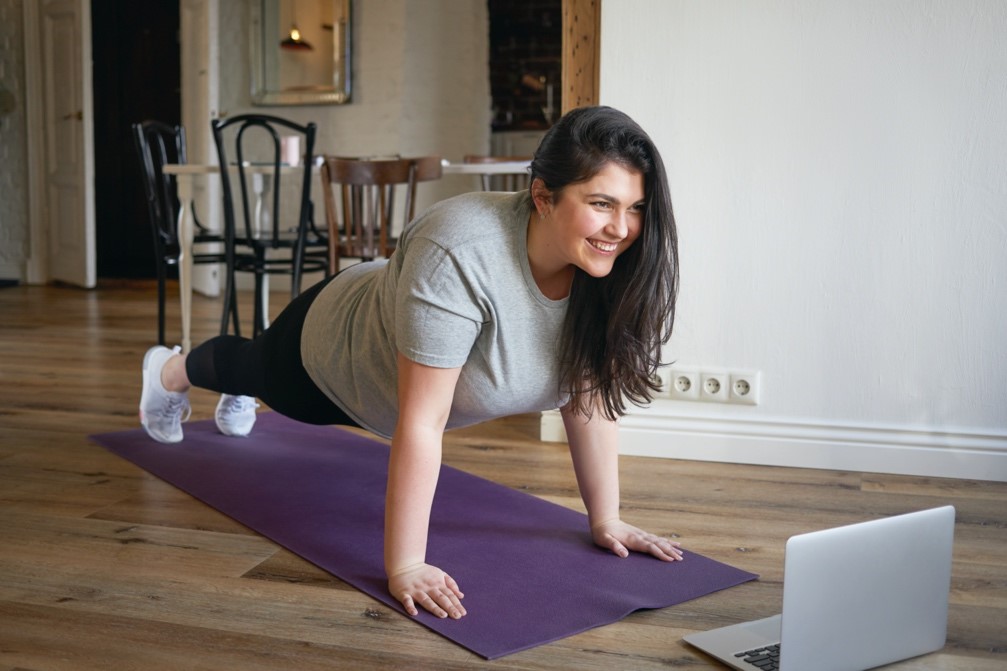Exercise physiology is all about supporting people to achieve better health, function and quality of life using safe and effective exercise programs.
How exercise physiology helped Kay lose weight and feel better
Kay has multiple health conditions and was struggling with variable energy levels and lack of stamina. She was also finding it difficult to maintain a healthy weight. These issues made it harder for Kay to participate in activities she enjoyed, such as taking short holidays.
Kay found Active Ability via the NDIS Service Provider listings. We provided exercise physiology services for Kay in the convenience of her own home.
Exercise is medicine for any condition, and Kay is living proof of this!
We asked Kay a few questions about her health and where she is at now. Here’s how Active Ability and exercise physiology helped Kay achieve her goals.
Background of my conditions:
I have complex co-morbidities – hypopituitarism, severe osteoarthritis and severe hearing loss. The biggest issues for me are a lack of sustainable stamina and variable energy (from hypopituitarism) and joint pain issues/lack of mobility (from arthritis).
How has exercise physiology helped me?
It was a struggle in the beginning (June 2017). I found it so hard to even complete the exercises both during the session with my EP and at other times. The exercises Emma provided me with were highly tailored specifically for my health issues.
I had a real setback in September 2017 when I found out that I had severe arthritis in my right hip. I was using a walking stick for a while. But the hip pain made me more determined to improve my exercise practice. A cortisone injection and acupuncture really reduced the hip pain, and this helped me to focus on exercising.
I started gradually improving the frequency of my exercises. It slowly became easier to complete a full set of exercises.
Now in 2018 I do my exercises most days (all at home in my bedroom) – 15 minutes of interval cycling, plus circuit and other exercises. This takes approximately 40-45 minutes.
Kay can easily complete her exercise program in the comfort and safety of her home
What difference has exercise made?
The best thing about doing the exercises is that I feel so much better afterwards. Even when I felt really tired, doing the exercises improves how I felt. My joints are more mobile, and I have more energy overall. My hip pain is only occasional and not severe.
I really notice if I miss a day or two. It’s harder when I re-start! But overall, I am much healthier. I weigh nearly 10kg less than I was in June 2017 and feel much improved. Hypnotherapy also helped me with weight loss.
Thank you heaps to Active Ability!
For the first time in 18 months I’m planning a few short breaks away to holiday, so looking forward to that a lot.
What can exercise physiology help with?
Research has proven that regular exercise has a host of benefits for physical and mental health.
Just a few of these include:
- Reduced risk of many chronic diseases, including diabetes, stroke and cardiovascular disease
- Supporting healthy brain function, memory and concentration
- Reducing symptoms of depression and anxiety
- Helping achieve and maintain a healthy weight
- Managing fatigue and energy levels
- Supporting better metabolism
- Improved stress management
- Managing stiffness and pain
- Lowering blood pressure
- Better quality sleep.
Why is exercise physiology so important for people with disability?
As the National Center on Health, Physical Activity and Disability (NCHPAD) point out[i], maintaining a high level of fitness is even more important for people with disability than for others in the general population. This is because a lack of strength and fitness can erode a person’s ability to work, care for themselves, and participate in social and community activities.
Furthermore, people with disability are at higher risk for developing chronic health conditions such as diabetes and cardiovascular disease. In fact, there’s a two-way relationship between disability and chronic health issues.[ii] In other words, people with disability are more likely to develop a health condition, and people with a health condition are more likely to develop disability.
This link can at least partly be explained by the way disability and health issues can impact a person’s capacity to be physically active. Whether the disability or the health condition comes first, lack of physical activity can create a downward spiral that leads to further health problems and disability.
In Kay’s case, for example, hypopituitarism and osteoarthritis led to low energy and reduced activity. In turn, this led to weight gain and further loss of mobility. The extra weight carried and lack of mobility created more problems, further complicating her metabolism and arthritis.
Unless something happens to break it, this vicious cycle can continue, causing further disability.
This is where exercise physiology can make all the difference (more about what applied exercise physiology is below).
Physical activity is an excellent way for people with disability to maintain health and wellbeing
Facts and figures about disability and health conditions
In February 2020, the NDIS Quality and Safeguards Commission released a report called Mortality patterns among people using disability support services in Australia.[i]
The report’s findings highlight why physical activity is vital for people with disability. Some of their findings were:
- people under age 65 using disability services were 4.7 times more likely to die compared to the general population under age 65.
- people with disability had a crude rate (not standardised for age or sex) of potentially avoidable deaths that was 3.6 times as high as that of the general population after adjusting for age.
- the leading potentially avoidable cause of death in the study population was coronary heart disease, followed by suicide.
- people with acquired brain injury had the highest rate of potentially avoidable deaths, followed by those with a primary disability related to vision, and psychosocial disability.
We don’t share these findings to alarm you. Rather, we want to emphasise how important it is for people with disability to proactively manage their health and wellbeing. One proven way to enhance physical and mental health is exercise.
What is applied exercise physiology?
Applied exercise physiology, also sometimes called clinical exercise physiology, is the study and application of research into how exercise affects the body. It focuses on using exercise and physical activity to promote good health and wellbeing for people with various goals. These goals may range from achieving elite sporting fitness to managing a diagnosed health condition.
Exercise physiologists are university-qualified health professionals who are experts at designing safe and effective exercise programs.
Active Ability’s exercise physiologists work almost exclusively with people with intellectual disability, mental health conditions and/or neurological conditions. This gives us a depth and breadth of experience supporting people with disability to achieve improved independence, quality of life and ability to participate at home, school, work and in the community.
We do this by using exercise as medicine to enhance health and function.
In what ways might exercise physiology help me?
Exercise physiology is not about turning you into a gym junkie or fitness fanatic – unless that’s what you want! Rather, it’s about creating a program that supports your goals. It’s vital that your exercise program is designed to be performed safely and personalised to your health needs. It also needs to fit in with your everyday life.
Exercise physiologists create safe, effective exercise programs tailored to your needs
If you have an intellectual disability, mental illness or neurological condition, Active Ability’s exercise physiologists have the training, experience and skills to assess your needs and design an exercise program tailored to your goals.
Just like we did for Kay, we can create a program that can be done easily at home or another preferred environment. We’ll help you get started and make sure you’re performing the exercises safely and effectively, to ensure they have the most benefit.
We’ll also monitor and adjust your program as needed. For example, we might adapt your program if you have an acute health issue such as an injury or infection or, like with Kay, we might increase your program gradually as your fitness and health improve.
Your program may include:
Cardiovascular conditioning/aerobic fitness
These exercises raise your pulse and breathing rate and condition the heart, lungs and circulatory system. They are helpful for:
- improving metabolic health (eg blood glucose and lipid control)
- supporting bone health (weight-bearing exercises)
- losing weight or maintaining a healthy weight
- improving mental health
- improving sleep
- relieving stress
Common examples include walking, cycling, swimming, boxing, dancing and rowing.
Your cardiovascular program may be performed in or outdoors. Kay, for example, used a stationary bike which fitted neatly into a corner of her bedroom.
Strength training
Strength or resistance training challenges your muscles, which helps them to become stronger and better able to cope with loads. They are helpful for:
- enhancing your capacity to manage daily tasks, such as lifting groceries or laundry
- improving your balance and reducing falls risk
- supporting better cardiometabolic health
- improving your posture
- managing your weight
- supporting bone health
- improving mental health
- relieving stress.
Strength training doesn’t mean lifting big weights or developing bulging muscles! For most people, exercises using body weight or simple equipment (such as resistance bands or small dumbbells/weighted balls) is more than adequate to achieve significant positive changes.
Balance training
This involves exercises that challenge the body’s balance mechanisms, which include the inner ear and nerve endings in your muscles and tendons.
Balance training can help you:
- stay steady on your feet, so you feel more confident getting around your home and community
- reduce the risk of having a fall.
Flexibility
Flexibility exercises aim to make your joints and muscles more mobile. They involve stretching tight areas of the body, so, like Kay, you can experience relief from stiffness and greater freedom of movement.
Our exercise physiologists can educate you or your support people to help you complete your exercise program effectively. Plus, we can provide education and advice about other health and wellbeing strategies, such as healthy nutrition and quality sleep.
If we feel you could benefit, and with your permission, we can also arrange services from other health professionals such as our dietitians and physiotherapists .
Don’t wait to do something that could make a huge difference for your health and quality of life! Find out more about Active Ability’s NDIS exercise physiology services here.
Or get in touch with us on (02) 8678 7874, hello@activeability.com.au or via our contact form.
References:
[1] https://www.nchpad.org/94/699/Resistance~Training~for~Persons~with~Physical~Disabilities
[2] https://www.aihw.gov.au/reports/dis/73-1/people-with-disability-in-australia/health/chronic-conditions-and-disability
[3] https://www.ndiscommission.gov.au/2020-report-mortality-patterns


